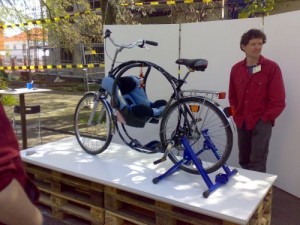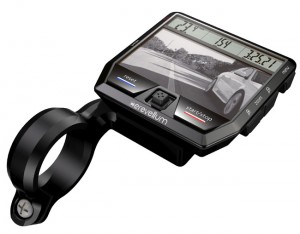Designers: Mark Law & David Law for Particle Design
Link with Intel from Particle Design on Vimeo.



Yanko Design
Link with Intel from Particle Design on Vimeo.



Yanko Design

The aim of VIENNA DESIGN WEEK is to show and enable people to experience the many-faceted creative work in the fields of product, furniture and industrial design as well as experimental design. After three successful festivals yet another exquisite and colourful programme of events will be awaiting the visitors this October. Design has been and is an important field in the production of culture: it shapes our material culture, our everyday life and our consumer world, it influences our lifestyles and fashions and most fundamentally our aesthetic sense and judgements. This wide-ranging impact is a reason both to celebrate design and to examine it critically, and VIENNA DESIGN WEEK has made both of these its mission.
In cooperation with many partners – from Vienna museums to production and retail companies to designers from all over the world – the whole of Vienna becomes a platform and showplace of design. VIENNA DESIGN WEEK doesn't have the character of a trade fair but instead offers a variety of venues and approaches specific to Vienna. The festival sets out to be "international but localised", with an abiding interest to cooperate with the flourishing design scenes of Central and Eastern Europe, and certainly beyond. Bringing to Vienna an important international design show every October is another example of the long-due international exchange VIENNA DESIGN WEEK is stimulating.
The festival aims to reveal creative and production processes and encourage experimental work on the spot. It also presents and promotes design that in the first instance withdraws from the scheme of utility value and functionality in order to create awareness and pose questions or also simply just to have fun. The exploration of materials, mood values and the interaction between people and objects lie at the centre of design practice and consequently are important points of reference within VIENNA DESIGN WEEK.
With exhibitions, venue-specific installations, theme specials, discussion events, a programme of films and, of course, enough opportunity to party and network, VIENNA DESIGN WEEK is not only an attraction for the international design scene but most explicitly also aims to interest and appeal to a wide public audience of Viennese and visitors to Vienna. This year VIENNA DESIGN WEEK energetically goes into the fourth round taking up a firm place on the international festival scene while being a fixed early-autumn cultural event in Vienna.

While I am posting, I want to pass along a few additional links of interest.
Yannig Roth recently covered Bike Expo 2010 in Munich and he shared some interesting thoughts on the future of design in the bicycle industry in a blog post.
Treehugger posted about Monochrome Recycled Bikes, an initiative by Argentine designers Natan Burta and Alejandro Sanguinetti. As the post points out, the interesting part is not only that they recycle and refurbish the bikes, but that they do so while maintaining a branded identity.
Dave Weagle, inventor of the DW link used on Turner and Ibis full suspension frames, has patented a concentric dropout pivot suspension system called Split Pivot , which allows the rear axel to function as the pivot point. You can expect to see this system used on bikes from quite a few brands next year. Read more at Bike Biz and Bike Rumor.
Finally, I will mention this solar powered bike sharing system for Copenhagen. As bike sharing programs become more prevalent, I suspect that designers will increasingly view them as a unified system integrated into an overall transportation plan rather than an unrelated collection of parts… sort of like this, this, or this.
Bycicle Design

Evan, who was a 2004 Kansas state champion cyclist, explains that an accident prompted him to design and develop the product. After 15 years of accident free riding, he was hit by a car in 2007. “I landed on my face,” he recalls. “The ac cident really shook me up. I did a few more races, but eventually lost my drive.” Fortunately, Evan chose to focus on the design for a cyclometer with a rearview camera at that time. “I wanted to create something to make it safer to ride a bike. My design background really helped me pull the pieces togeth er. Everything—the skills and the resources—fell into place.”
In addition to displaying the current rearview on the screen, the unit features accident detection and recording (a very useful feature that a few commenters suggested in response to the earlier posts). It will also offer ANT+ compatibility for heart rate and power-measuring systems, and a GPS antenna for a mapping software upgrade in 2012. As you can tell from my past posts, this is a product that I am pretty excited about. I can’t wait to try it out once it is available and I will share my impressions when I do.
Bicycle Design
Công ty cơ khí nông nghiệp DeLaval của Thụy Điển vừa phát minh máy chuyên dùng để tắm rửa và chải chuốt cho bò sữa. |
| Theo Vietnam+ |
Trong chiến tranh, đổi mới vũ khí có thể mang tới chiến thắng ngoạn mục cho phe này và gây thất bại bất ngờ cho phe kia. Tuy nhiên cũng có những sáng kiến rất quái dị, thậm chí "điên khùng".
Nguồn: Xinhua, defence.pk | |
| Theo Tuổi Trẻ |
Mất một giờ đồng hồ, với chi phí từ 90.000 - 600.000 đồng, các bạn học sinh đã có thể tự lắp một chiếc kính thiên văn...
|
| Theo Báo Đất Việt |
"Da Vinci", robot phẫu thuật tiên tiến nhất trên thế giới hiện nay, vừa ghi tên mình vào lịch sử y học châu Âu khi thực hiện thành công ca ghép thận cho một phụ nữ 37 tuổi ở Ý.
Giáo sư Hugh Boggi và "bác sĩ Da Vinci" (Ảnh: The Sun) Bệnh nhân là chị Giuliana Campanani, bị suy thận mạn tính. Người hiến thận chính là mẹ ruột chị, bà Manuela Staderini. Người mẹ 57 tuổi này đã đồng ý trải qua ca phẫu thuật kéo dài 50 phút tại bệnh viện ĐH Pisa (Ý) để cứu con gái. "Bác sĩ Da Vinci" đã thực hiện ca phẫu thuật chính xác và khéo đến nỗi Trưởng khoa phẫu thuật - cấy ghép của bệnh viện, giáo sư Ugo Boggi, phải thốt lên: "Đây là ca ghép thận đầu tiên tại châu Âu do robot thực hiện và 'tốn' ít đường rạch mổ nhất". "Dự kiến ca phẫu thuật kéo dài 2 giờ, nhưng chỉ sau 50 phút đã xong. Quả thận ghép sau đó đã lập tức hoạt động", ông cho biết thêm.
Bà Manuela Staderini (áo trắng) và con gái Giuliana Campanani (giữa) (Ảnh: The Sun) Được biết ca phẫu thuật diễn ra vào đầu tháng 7, và Guiliana vẫn đang được theo dõi để xem cơ thể chị có đào thải quả thận mới hay không. |
| Theo TTO |
Quy trình STEP sử dụng năng lượng và nhiệt lượng mặt trời để thu gom CO2 vừa được các nhà khoa học Mỹ công bố. Sử dụng ánh sáng mặt trời để cung cấp năng lượng cho các tế bào điện phân để tách đôi CO2, đồng thời sử dụng nhiệt lượng mặt trời để nung nóng tế bào nhằm giảm mức năng lượng cần cho quá trình chuyển đổi. Như vậy, với phương pháp sử dụng ánh sáng và nhiệt lượng mặt trời để hấp thụ và chuyển đổi CO2 từ không khí, có thể làm sạch khí quyển và đồng thời sản xuất nhiên liệu cho máy móc.
Trong ảnh là quy trình thu gom CO2 bằng năng lượng mặt trời gọi là Lợi thế then chốt của quy trình thu gom carbon bằng năng lượng mặt trời mới này là sử dụng đồng thời ánh sáng và sức nóng mặt trời. Trong khi sức nóng mặt trời thường bị xem là bất lợi vì có thể làm các vật liệu quang điện xuống cấp, phương pháp mới lại sử dụng sức nóng đó để chuyển nhiều năng lượng mặt trời vào carbon hơn so với việc chỉ dùng riêng quy trình quang điện hoặc quang nhiệt. Quy trình mới được gọi là quy trình thu gom carbon bằng điện hóa học và nhiệt lượng mặt trời, gọi tắt là STEP. Đây là quy trình đầu tiên và duy nhất sử dụng đồng thời ánh sáng và nhiệt lượng mặt trời để hấp thu carbon. Quy trình này được một nhóm các nhà khoa học thuộc ĐH George Washington và ĐH Howard đệ trình về mặt lý thuyết gần đây và lần đầu được mô tả thực nghiệm trong tờ báo The Journal of Physical Chemistry. Theo Phyorgs, GS Stuart Licht – GS Hóa học tại ĐH Washington cho biết mặc dù CO2 là một hợp chất không phản ứng và thường khó bị lấy đi nhưng vẫn có thể dễ dàng được hấp thụ nhờ việc dùng năng lượng mặt trời trong quy trình STEP điện phân muối lithium carbonate. GS Stuart Licht tin tưởng rằng quy trình này sẽ giảm lượng CO2 trong khí quyển bằng với thời tiền công nghiệp chỉ trong vòng 10 năm.
Giải pháp cây nhân tạo hấp thu CO2 từng được đưa ra nhưng chi phí Theo sự giải thích của các nhà khoa học, quy trình sử dụng ánh sáng mặt trời để cung cấp năng lượng cho các tế bào điện phân để tách đôi CO2, đồng thời sử dụng nhiệt lượng mặt trời để nung nóng tế bào nhằm giảm mức năng lượng cần cho quá trình chuyển đổi. Những tế bào điện phân tách CO2 thành carbon lỏng (khi phản ứng xảy ra ở nhiệt độ từ 750 – 850 độ C) hoặc CO (khi phản ứng xảy ra ở nhiệt độ trên 950 độ C). Những thí nghiệm của nghiên cứu cho thấy kỹ thuật này có thể hấp thu và chuyển đổi CO2 tiết kiệm năng lượng đến 34 – 50% nhờ việc sử dụng cả nhiệt lượng mặt trời. Bên cạnh carbon có thể được lưu giữ lại, các nhà khoa học còn dùng CO và hydro phát sinh trong quy trình STEP phân tách nước để có thể tổng hợp nhiên liệu diesel và xăng. Nguồn: Physorg |
| Theo Vietnamnet |

A one-day conference for professionals who design hardware or software for consumer electronics, appliances, and mobile devices.










Check out the schedule of events for talk descriptions and the day's events or REGISTER NOW.
Pro-ID Design by Topwpthemes. Converted By Ha Nam Son , Email: pro.idgroup.vn@gmail.com Or swin9986@gmail.com .